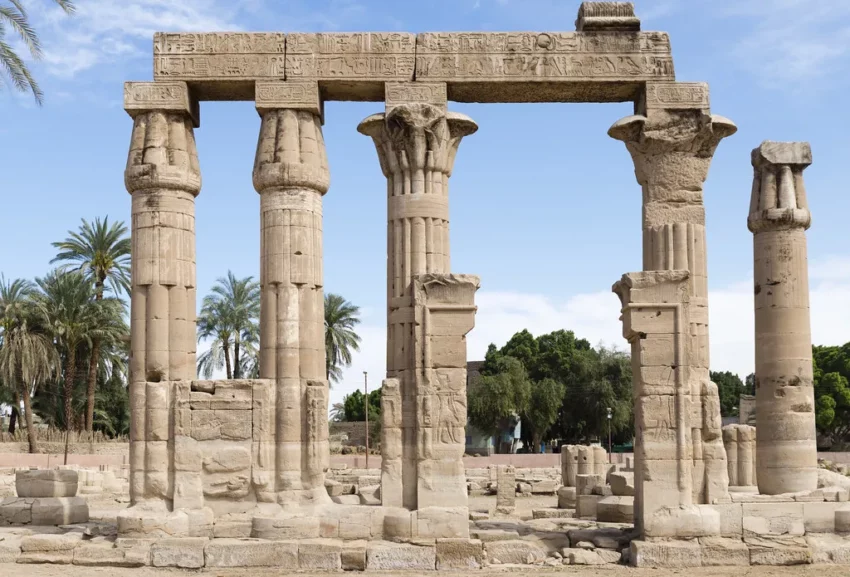The Temple of Montu, dedicated to the falcon-headed god of war Montu, stands as a testament to the religious fervor and architectural grandeur of ancient Egypt. Located in modern-day Armant, near Luxor, this temple complex showcases the evolution of Egyptian temple design and religious practices. It was a significant cult center during the Middle Kingdom and continued to play a vital role throughout the New Kingdom and Greco-Roman periods.
Get your dose of History via Email
Historical Background of the Temple of Montu
The Temple of Montu was discovered by European travelers in the 19th century, with its ruins hinting at a once-majestic past. It was built by Pharaoh Senusret III during the Middle Kingdom, around 1878-1839 BC. Over time, the temple saw additions and restorations by various pharaohs, including those from the New Kingdom and the Ptolemaic dynasty. The site was not only a religious center but also a strategic military ground, reflecting Montu’s warrior aspect.
Pharaohs such as Amenhotep III and Ramses II are known to have made significant contributions to the temple’s structure. The temple complex expanded, with new precincts and chapels added to honor Montu. During the Ptolemaic era, the temple underwent further enhancements, showcasing the blend of Egyptian and Greek architectural styles.
Later, the Romans used the site, leaving their mark on the temple’s history. The temple’s strategic location near Thebes made it a focal point for various historical events, including military campaigns. The worship of Montu declined with the rise of Christianity, leading to the temple’s eventual abandonment.
Excavations in the 20th century have unearthed significant artifacts and inscriptions, shedding light on the temple’s extensive history. These findings have helped historians piece together the temple’s evolution and its role in ancient Egyptian society.
The Temple of Montu, though not as intact as other Egyptian temples, remains a crucial archaeological site. It provides valuable insights into the religious and military significance of Montu worship in ancient Egypt.
About the Temple of Montu
The Temple of Montu, constructed primarily of sandstone and mudbrick, is a marvel of ancient Egyptian architecture. Its design follows the classic temple structure, with pylons, courtyards, hypostyle halls, and sanctuaries. The temple’s entrance once featured a grand pylon, leading to an open courtyard surrounded by columns.
Inside, the hypostyle hall boasted intricately carved columns, each telling stories of the pharaohs and their divine connections to Montu. The innermost parts of the temple housed the sanctuary, where the god’s cult statue resided. This area was considered the most sacred and was accessible only to the priests.
Architectural highlights include the remaining colossal statues and the impressive gateway built by Ptolemy III. The temple’s walls and columns are adorned with reliefs and inscriptions, depicting various deities and scenes of pharaohs making offerings to Montu.
Despite the temple’s dilapidated state, the craftsmanship of the carvings and the layout of the complex remain impressive. The use of both sandstone and mudbrick in construction reflects the availability of materials and the temple’s various phases of development.
Over the centuries, the temple has faced damage from natural elements and human activity. However, the remaining structures still convey the grandeur of the temple and its importance in ancient Egyptian religion.
Theories and Interpretations
The Temple of Montu has been the subject of various theories and interpretations. Scholars believe it served as a key religious and military site, reflecting the dual aspects of Montu as a god of war and creator. The presence of military-themed inscriptions supports this theory.
Some mysteries surround the temple, such as the exact rituals performed within its walls. While no definitive texts have been found, the reliefs suggest offerings and processions were common practices.
Historians have matched the temple’s features with ancient records, confirming the involvement of several pharaohs in its construction. The temple’s alignment and architectural elements have also been analyzed to understand its religious significance.
Dating of the temple has been carried out using architectural styles, inscriptions, and historical records. Carbon dating of organic materials found on-site has provided additional chronological data.
The temple’s decline and the shift in religious practices have led to interpretations of the socio-political changes in Egypt during the late antiquity period. The transition from paganism to Christianity is evident in the temple’s later adaptations.
At a glance
Country: Egypt
Civilization: Ancient Egyptian
Age: Approximately 3800 years old (circa 1878-1839 BC)

